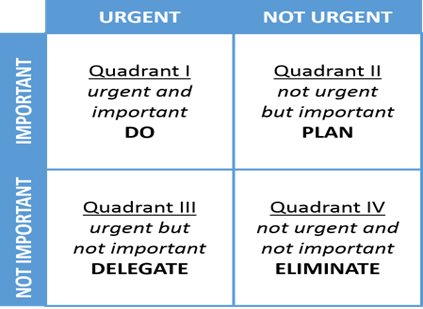Time is probably the number one challenge middle leaders in schools face, or rather, not enough of it. Most are trying to balance their leadership and management roles with significant teaching responsibilities – there’s too much to do and not enough time to do it in.
Here are NAHT’s tips for middle leaders.
Make peace with your to-do list
Learn to accept that you’ll never complete your to-do list – making your peace in this respect is an important first step. The only real option is to make sure you spend the amount of time you do have on the things that really matter – learn how to prioritise.
Prioritising
Take a tip from Steven Covey’s ‘The 7 Habits of Highly Effective People’. This is essentially an alternative to a standard to-do list. Rather than simply writing all your tasks down in a single list, you have to decide how urgent and important you deem each of them to be and place them in one of four quadrants based on your decision:

Those items that fall into the ‘urgent and important’ box are the place to start. You need to do these tasks, and they need to be done well. Tackle these first.
Those that fall into the ‘urgent but not important’ category can, unfortunately, take up a lot of our time. You probably do need to get these done, and there is an upcoming deadline that means you can’t put them off indefinitely. However, as you have deemed these tasks are not that important, resist the urge to spend too much time on them.
A critical box for leaders in schools is the ‘not urgent but important’ box. As there’s no looming deadline, these can often get pushed to the bottom of our list, and we never quite get around to doing them because we focus instead on the immediate, fire-fighting tasks.
However, these are often the tasks that can have a significant and lasting impact. It could include time reading, thinking and planning for specific strategic projects related to your area of leadership, e.g. updating the school’s behaviour policy. As leaders, we need to try and find some time to spend on these items otherwise there’s a real danger we’re constantly living in survival mode, i.e. we’re managing the status quo, but not bringing about meaningful change and improvement.
The final box is relatively easy. If you have anything on your list that you deem to be ‘not urgent and not important’, don’t do it!
The challenge with this model is determining what you deem to be important (the urgency part is usually decided for us). One way of thinking about this is to ask yourself the following: “will anyone remember this in a few years’ time?” – for example, if you can develop a new approach to reading that means more pupils leave your school as proficient readers, you have potentially transformed lives – this is a lasting change that will be remembered!
Ask yourself – when am I at my best? Are you a night owl or a morning lark? Some of us are simply more productive at different times of the day. Consider when you are at your most productive and find ways to try and maximise this.
No magic wand
Sadly, there is no magic wand when it comes to time management; if there were, we’d all know about it by now! As a teacher and school leader, you’ll almost certainly always have too much on your plate at any one time, but by employing a few simple tools and strategies, it is possible to increase your chances of spending the limited amount of time you have on the things that really matter.
—
About NAHT
NAHT is the leading union for school leaders’ and as a member you get access to legal support and advice, discounts and deals on your daily purchases, access to a mentoring scheme and savings on our highly-rated CPD courses and conferences. To join us, visit out membership page.

